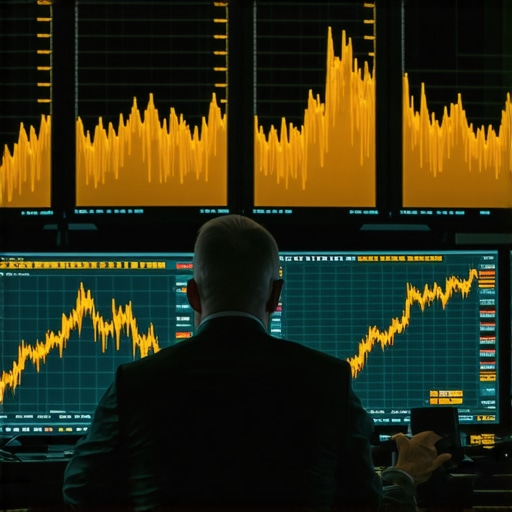Understanding Gold Futures: A Primer for Investors
Investing in gold futures can be an excellent strategy for diversifying your portfolio and hedging against economic uncertainties. Gold has long been viewed as a safe-haven asset, particularly during times of inflation or geopolitical tension. However, navigating the world of gold futures requires a solid understanding of the market and an awareness of the unique complexities involved.
The Basics of Gold Futures Trading
Before diving into the steps and considerations for investing in gold futures, it’s crucial to grasp what gold futures are. Essentially, a futures contract is a legal agreement to buy or sell a specific quantity of gold at a predetermined price on a specified future date. This allows investors to speculate on the price movement of gold without needing to own the physical asset. By understanding how futures work, you can better position yourself in the market.
Why Invest in Gold Futures?
There are several compelling reasons to consider gold futures as part of your investment strategy:
- Leverage: Futures trading allows you to control a larger position with a smaller initial investment, potentially magnifying your returns.
- Hedging: If you own physical gold or gold-related investments, futures can help you protect against price declines.
- Liquidity: Gold futures are highly liquid, meaning you can easily enter and exit positions.
Steps to Successfully Invest in Gold Futures
The journey into gold futures begins with several essential steps:
1. Research and Understand the Market
Before making any investment, it’s vital to conduct thorough research. Familiarize yourself with the factors that influence gold prices, including economic indicators, central bank policies, and global events. For insights on how these elements affect gold prices, check out our article on the impact of global events on gold prices.
2. Choose a Reputable Broker
Selecting the right brokerage is critical. Look for brokers who offer competitive fees, robust trading platforms, and excellent customer support. Read reviews and consider their reputation within the trading community.
3. Develop a Trading Strategy
Your investment strategy should be tailored to your financial goals and risk tolerance. Determine whether you plan to trade short-term or hold positions for the long term. Ensure your strategy includes clear entry and exit points to maximize profits and minimize losses.
4. Monitor Market Trends
Stay updated on market trends and news that could impact gold prices. Resources such as gold price analysis articles can provide valuable insights into current market dynamics.
Considerations Before Investing
While gold futures can be lucrative, they also come with inherent risks. Be mindful of the following:
- Volatility: Gold prices can be highly volatile, leading to significant fluctuations in your investment value.
- Margin Requirements: Futures trading often involves margin, meaning you may need to maintain a minimum account balance.
- Knowledge and Experience: Ensure you have a solid understanding of futures trading before diving in. Consider practicing with a demo account.
In conclusion, investing in gold futures can be a rewarding venture if approached with care and due diligence. By understanding the market, developing a sound strategy, and being aware of potential risks, you can position yourself for success in this exciting investment arena.
Advanced Strategies for Trading Gold Futures
Once you have a foundational understanding of gold futures, it’s time to explore advanced strategies that can enhance your trading effectiveness. These strategies can help you navigate market fluctuations and make informed investment decisions.
1. Spread Trading
Spread trading involves taking positions in two related futures contracts simultaneously. This strategy aims to profit from the difference in price movements between the two contracts. For example, you might go long on a near-term gold futures contract while simultaneously going short on a longer-term contract. This approach can mitigate risk while capitalizing on price discrepancies.
2. Utilizing Technical Analysis
Technical analysis is a powerful tool for gold futures traders. By analyzing historical price data and identifying patterns, you can make educated predictions about future price movements. Incorporating indicators such as moving averages and Relative Strength Index (RSI) can provide deeper insights into market trends. For a more comprehensive understanding of market trends, consider reviewing our gold price analysis articles.
3. Hedging with Options
Options trading can also serve as a hedging strategy for futures contracts. By purchasing options, you secure the right, but not the obligation, to buy or sell a futures contract at a predetermined price. This can provide a safety net against adverse price movements while allowing you to capitalize on favorable trends.
Factors Influencing Gold Futures Prices
Understanding the factors that influence gold futures prices is critical for making informed investment decisions. Here are some key elements to consider:
Global Economic Conditions
The state of the global economy significantly impacts gold prices. In times of economic uncertainty, investors often flock to gold as a safe haven. Monitoring economic indicators such as GDP growth, unemployment rates, and inflation can help you anticipate price movements.
Central Bank Policies
Central banks play a significant role in the gold market, particularly through their purchasing decisions. When central banks increase their gold reserves, it can lead to increased demand and higher prices. Keeping an eye on central bank policies and announcements can provide valuable insights into potential market shifts. For a deeper dive into this topic, check our article on central bank gold purchases.
Geopolitical Events
Geopolitical tensions often lead to increased volatility in gold prices. Events such as conflicts, trade wars, or significant political changes can spur demand for gold as a hedge against instability. Staying informed about global events can help you make timely investment choices.
Risk Management in Gold Futures Trading
Effective risk management is crucial when trading gold futures. Here are some strategies to consider:
Setting Stop-Loss Orders
Implementing stop-loss orders can protect your investment by automatically closing your position when it reaches a predetermined price. This helps mitigate losses and allows you to manage your risk more effectively.
Diversification
Diversifying your investment portfolio can reduce risk. Consider allocating a portion of your funds to various asset classes, including gold, stocks, and bonds. This approach can help you weather fluctuations in any single market.
Continuous Education
The gold market is constantly evolving, and staying informed is essential. Regularly educate yourself on market trends, strategies, and economic factors that influence gold prices. For those beginning their journey in gold investing, our beginner’s guide to investing in gold is an excellent resource.
Advanced Risk Management Techniques in Gold Futures Trading
In the realm of gold futures trading, implementing effective risk management techniques is vital for protecting your investments and ensuring long-term success. Here are several strategies to enhance your risk management approach:
1. Position Sizing
Position sizing refers to determining the amount of capital to allocate to a particular trade. By using a calculated approach to position sizing, you can limit potential losses on any single trade. A common rule of thumb is to risk no more than 1-2% of your total trading capital on a single trade. This discipline helps maintain a balanced portfolio and reduces the impact of any adverse price movements.
2. Risk-Reward Ratio
Assessing the risk-reward ratio is essential in gold futures trading. This ratio compares the potential profit of a trade to the potential loss. A favorable risk-reward ratio, typically 2:1 or higher, indicates that the potential reward outweighs the risk involved. This analysis helps traders make informed decisions and encourages disciplined trading practices.
3. Utilizing Trailing Stops
A trailing stop is a dynamic form of a stop-loss order that adjusts as the price of gold moves in your favor. By setting a trailing stop, you can lock in profits while allowing for further potential gains. This technique is particularly useful in volatile markets, where prices can fluctuate significantly.
Market Trends and Their Implications
Understanding market trends is crucial in gold futures trading. Key market trends can provide insights into potential price movements and inform your trading strategies:
Long-Term Bullish Trends
A long-term bullish trend in gold prices often indicates strong demand and can signal favorable trading conditions. Investors typically respond to bullish trends by increasing their positions, which can lead to further price appreciation. For a deeper understanding of the current market environment, refer to our article on gold price forecasts.
Bearish Market Conditions
Conversely, bearish market conditions can present challenges for gold futures traders. In times of declining prices, it’s essential to reassess your strategies and consider alternative investments. Implementing protective measures, such as hedging or diversifying your portfolio, can mitigate the impact of a bearish trend.
Leveraging Technology in Gold Trading
The advancement of technology has transformed the landscape of gold trading. Here are some ways that technology can enhance your trading experience:
Trading Platforms and Tools
Modern trading platforms offer a wide range of tools and features that can improve your trading efficiency. From real-time market data to advanced charting capabilities, utilizing these resources can help you make informed decisions swiftly. Many platforms also provide automated trading options, allowing you to execute trades based on predefined criteria.
Market Analysis Software
Employing market analysis software can help you stay ahead of trends and identify potential investment opportunities. These tools often include comprehensive analytical features, allowing you to analyze historical data, monitor price movements, and apply various technical indicators. For traders looking to enhance their skills, exploring our article on analyzing gold market trends can provide valuable insights.
Conclusion
In conclusion, mastering gold futures trading requires a combination of strategic planning, effective risk management, and continuous education. By implementing the techniques discussed, traders can navigate the complexities of the gold market with greater confidence and achieve their investment goals.
Understanding Technical Analysis in Gold Futures
Technical analysis plays a pivotal role in gold futures trading, enabling investors to make informed decisions based on historical price movements and market trends. By utilizing various analytical tools and indicators, traders can identify potential entry and exit points, enhancing their trading strategies.
Key Indicators and Tools
Several key indicators are essential for effective technical analysis in gold futures trading. Moving averages, Relative Strength Index (RSI), and Fibonacci retracement levels are commonly used to gauge market momentum and potential reversals. For instance, moving averages help smooth out price data and identify trends, while RSI provides insight into whether a market is overbought or oversold, guiding traders in their decision-making processes.
Chart Patterns
Recognizing chart patterns such as head and shoulders, triangles, and flags can also inform trading strategies. These formations often indicate potential price movements, allowing traders to anticipate market behavior. By integrating technical analysis with other strategies, such as fundamental analysis, you can develop a comprehensive approach to gold futures trading.
Fundamental Analysis: The Big Picture
While technical analysis focuses on price movements, fundamental analysis provides a broader perspective on factors influencing gold prices. Understanding the underlying economic conditions and geopolitical events is crucial for making informed trading decisions.
The Role of Economic Indicators
Economic indicators, such as inflation rates, interest rates, and employment data, significantly impact gold prices. For example, higher inflation often leads to increased demand for gold as a hedge against currency devaluation. Additionally, changes in interest rates can affect gold’s attractiveness compared to interest-bearing assets. Staying informed about these indicators can help you anticipate market shifts and adjust your trading strategies accordingly.
Geopolitical Factors
Geopolitical events, such as conflicts or changes in government policies, can also influence gold prices. Investors often flock to gold in times of uncertainty, driving up its value. Keeping an eye on global events and understanding their potential impacts on the gold market is vital for any trader. For further insights into how global events affect prices, explore our article on the impact of global events on gold prices.
Implementing Psychological Strategies
Psychological factors play a significant role in trading, and understanding market psychology can enhance your trading performance. Recognizing common psychological traps, such as fear and greed, is essential for maintaining discipline and making rational decisions.
Building a Trading Plan
Creating a comprehensive trading plan that outlines your goals, strategies, and risk management techniques is crucial for success in gold futures trading. A well-defined plan helps mitigate emotional reactions to market fluctuations and provides a roadmap for your trading activities.
Continuous Education and Adaptation
Finally, continuous education and adaptation to market changes are vital for long-term success in gold futures trading. Engaging in ongoing learning, whether through online courses, webinars, or reading materials, can enhance your trading skills and keep you updated on market developments. For new traders, our guide on how to invest in gold offers valuable insights into the essential concepts of gold trading.
Frequently Asked Questions about Gold Futures Trading
What are gold futures?
Gold futures are contracts that obligate the buyer to purchase, and the seller to sell, a specified amount of gold at a predetermined price on a set future date. They are used by investors to hedge against price fluctuations and speculate on gold price movements.
How do I start trading gold futures?
To begin trading gold futures, you need to open a brokerage account that offers futures trading. After funding your account, you can begin analyzing market data and utilizing technical and fundamental analysis strategies to make informed trading decisions.
What factors influence gold futures prices?
Several factors affect gold futures prices, including economic indicators like inflation and interest rates, geopolitical events, currency strength (especially the US dollar), and overall market demand for gold as a safe-haven asset.
Can I trade gold futures with a small amount of capital?
Yes, trading gold futures can be done with a relatively small amount of capital due to margin requirements. However, it’s essential to understand the risks involved, as trading on margin can amplify both gains and losses.
What is the difference between gold futures and gold ETFs?
Gold futures are contracts for the future delivery of gold, while gold ETFs (Exchange-Traded Funds) are investment funds that track the price of gold. Gold ETFs can be bought and sold like stocks, providing a more accessible way to invest in gold without dealing with futures contracts directly.
How do I analyze gold futures?
Analyzing gold futures involves using both technical analysis, such as chart patterns and indicators, and fundamental analysis, focusing on economic conditions and market sentiment. A comprehensive approach will provide better insights for trading decisions.
Is gold futures trading risky?
Yes, trading gold futures carries risks, including market volatility and the potential for significant losses, especially when trading on margin. It is crucial to have a solid trading plan and risk management strategies in place before entering the market.
What are some common strategies for trading gold futures?
Common strategies include trend following, using technical indicators to identify entry and exit points, and hedging against price movements with options. Diversifying your trading approach can also help manage risks.
Authority Resources for Gold Futures Trading
For those looking to deepen their understanding of gold futures trading, several reputable resources can provide valuable insights:
- CME Group: Gold Futures – Official site for trading gold futures, offering educational resources and market data.
- Investopedia: Gold Futures Explained – Comprehensive guide on gold futures, including strategies and market analysis.
- Kitco: Gold Market News – A leading source for gold market news, analysis, and prices.
- Bloomberg: Commodities Market – Provides in-depth market analysis and news on commodities, including gold.
- World Gold Council – Offers research and insights into the gold market, including trends and investment information.
Conclusion: Navigating the Gold Futures Market
Mastering gold futures trading requires a blend of technical and fundamental analysis, an understanding of market psychology, and a commitment to continuous learning. By leveraging the strategies and insights discussed in this guide, you can enhance your trading performance and make informed decisions in the dynamic gold market. Remember, whether you’re a seasoned trader or just starting, staying updated with market trends and maintaining a disciplined approach are key to achieving success in gold futures trading.










